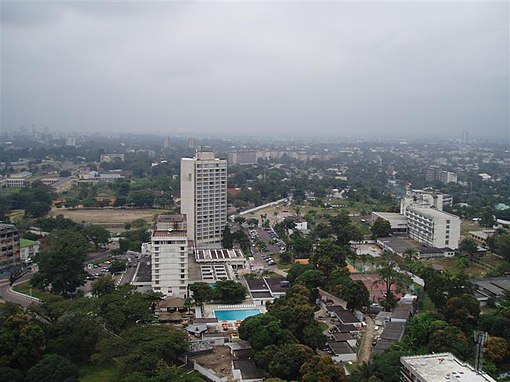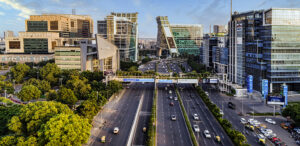Cities & Climate change: Time to stop mindless urbanisation

Bigger is definitely not better as many Asian and African megapolises, like Kinshasa in Democratic Republic of Congo (pictured above) show
In 1920, Kinshasa, the capital of Democratic Republic of Congo, was a small town that counted barely 20,000 people. Exactly 130 years later, in 2050, the city is expected to be the fourth largest in the world, with 35 million inhabitants, a number that will swell to over 83 million, making Kinshasa the second largest megapolis in the world, behind only another African capital, Lagos in Nigeria, which may have about 89 million people.
Both the cities are expected to be larger than most countries in the world at that time, save the top 12. As many as 10 cities around the world are expected to have more than 50 million inhabitants, making them bigger than all but 48 countries in the world.
None of the top 20 cities in the world would be from a developed country. New York, at 22nd and Tokyo at 28th spot are the only rich country cities to be in the top 30 at that time. Half the cities, 15 of top 30, would be from Africa.
Alongside many other red alerts currently on in the world, ranging from climate change, pollution, hunger, poverty and lack of biodiversity, we need to add the red alert on bloated cities that are certain to collapse on themselves unless some dramatic changes are made in our urban planning system.
Every single large city in the developing country and even many in the developed world are already creaking under their weight as the urban planners and city councils have failed to keep pace with the growth in the population, which has seen an endless flow from the rural areas to urban centres, not just in search of livelihood, but also looking for better social services like education or healthcare.
With failing, old and inadequate infrastructure, the urban centres have been struggling for decades to keep pace with rising population and their growing expectations of services from the city governments, there is hardly any large city anywhere in the world that can rest easy. The situation in the developing countries and especially in Asia and Africa is already calamitous with over two-thirds of urban population living in shanties, without access to reliable water or power supply and simply struggling to eke out a living. The cities are choking with water and air pollution and terrible waste management systems have led to a situation where almost every city is sitting next to mountains of garbage in the shape of landfills. If this is the situation today, it would be foolhardy to imagine these cities would be able to manage with four or five-fold growth in their populations.
Another big problem with urbanisation is that cities have become hotbeds of climate change. According to the World Bank, though cities account for just about half the world’s population, they are responsible for over 70 pc of global carbon emissions, most of which come from industrial and motorised transport systems that use huge quantities of fossil fuels and rely on far-flung infrastructure constructed with carbon-intensive materials. Moreover, the cities also consume a far greater share of natural resources like water on a per capita basis than the rural folk.
With a disaster staring at the world, it is time to go back to the drawing board and relook at urbanisation, which has long been propagated by planners and international organisations as being the solution for the world of tomorrow, claiming that cities make efficient usage of resources, by not being too spread out.
However, after almost six decades of massive urbanisation, most of it unplanned, at least in the developing world, has led to the cities emerging as unwieldy giants that are unmanageable, with all kinds of problems, ranging from high air pollution to lack of housing and other urban infrastructure that is supposed to come with a city. The migration from rural areas or other parts of the same country has led to a totally unbalanced situation as too many people are in the race for too few facilities. This has led to cities becoming hot beds of unemployment and crime.
With such a situation today, it is unimaginable what a city that is 3-5 times bigger would look like. When even large, rich cities like San Francisco or New York are unable to find a solution for many of their problems – housing, healthcare and education, it would be downright stupid to imagine that poor countries, with scarce resources to fix today’s problems even partially, can overhaul themselves and prepare the cities for the multi-fold growth.
It is time for the planners, especially those in the governments, to look back at what Mahatma Gandhi had been preaching all his life – decentralisation and making every village or at least a cluster of villages entirely self-dependent from all aspects, including social services and economy.
While looking at the mess in which the world is right now, it may sound utopian to look at Gandhi’s suggestion and undo the urbanization, but it is still very much possible to implement it in the developing countries, notably South Asia and Africa where a large majority of the population is still rural and it may be possible to look at development from the perspective of villages or clusters of villages rather than continuing down the path of unplanned and unmanageable urbanisation that the world has been witness to for the past half a century or more.
Indeed, a new look at the development model is needed the most in these two regions since they will be the ones with the largest burdens of nation-sized behemoths called urban conglomerations. If the rot can be slowed down immediately and reversed over time, it may yet be possible to offer every citizen a new lifestyle that would be in harmony with the nature and address the key challenges facing governments and urban planners today.
Smart Cities? Unmanageable megapolises in India
While many African countries will struggle for long to manage their largest cities, it is India that the worst challenge by far. Despite over 15 years of attempts by various governments to regulate the growth of urban centres, the situation has turned worse each year, compared to the previous year. The problems in Indian cities range from rampant construction, legal and illegal, on water bodies, riverbeds and other protected areas, widespread felling of trees, near-absent waste management, both solid and liquid, toxic levels of air pollution and a sharp divide between the few haves and millions of have-nots living cheek by jowl in Indian megapolises.
The hyped up Smart City Project launched by Prime Minister Narendra Modi in 2015 was meant to make 100 cities in India ‘Smart’, by making them more citizen-friendly and sustainable. The project was to have been completed between 2019 & 2023, but as we prepare to step into 2023, far from making 100 cities smart, the current government, with its laissez faire attitude and its proactive measures to prioritise so-called development at the expense of sacrificing whatever little ecology and nature remains in Indian cities has seen that every single city in India today is in a far worse situation than it was before the project began in 2015.
The recurring flash floods of India’s ‘silicon valley’ Bengaluru, that have become an annual ritual, have worsened due to greed of politicians, builders and government bodies that let large-scale unregulated construction take place all over the cities and kill all its seven lakes. Delhi’s air pollution levels continue to be at cancerous levels and extreme heatwaves are now a frequent, commonplace occurrence in Indian cities where they begin much earlier in the year, last many more days in the year and are more intense and widespread each year.
There is little chance of that changing unless a complete rethink happens on the issue of urban planning and not just Modi or other leaders of India, but the entire world would do well to brush up again the economic model proposed by Mahatma Gandhi over 100 years ago, where he called for a distributed development model, where each village developed as per its own needs and capacities, instead of everyone rushing to the urban areas for education or employment. Only then can we begin to curb the mindless rise in global temperatures and carbon emissions.










